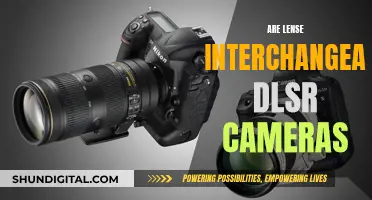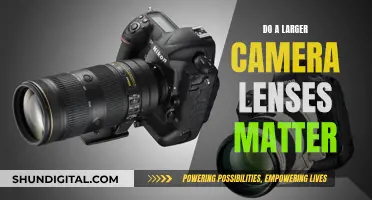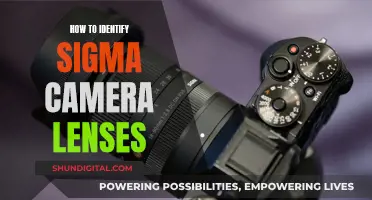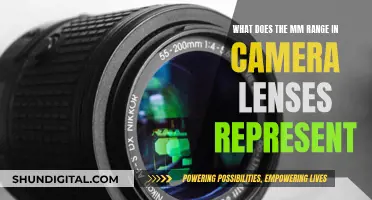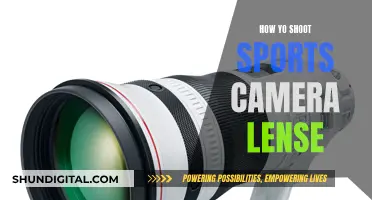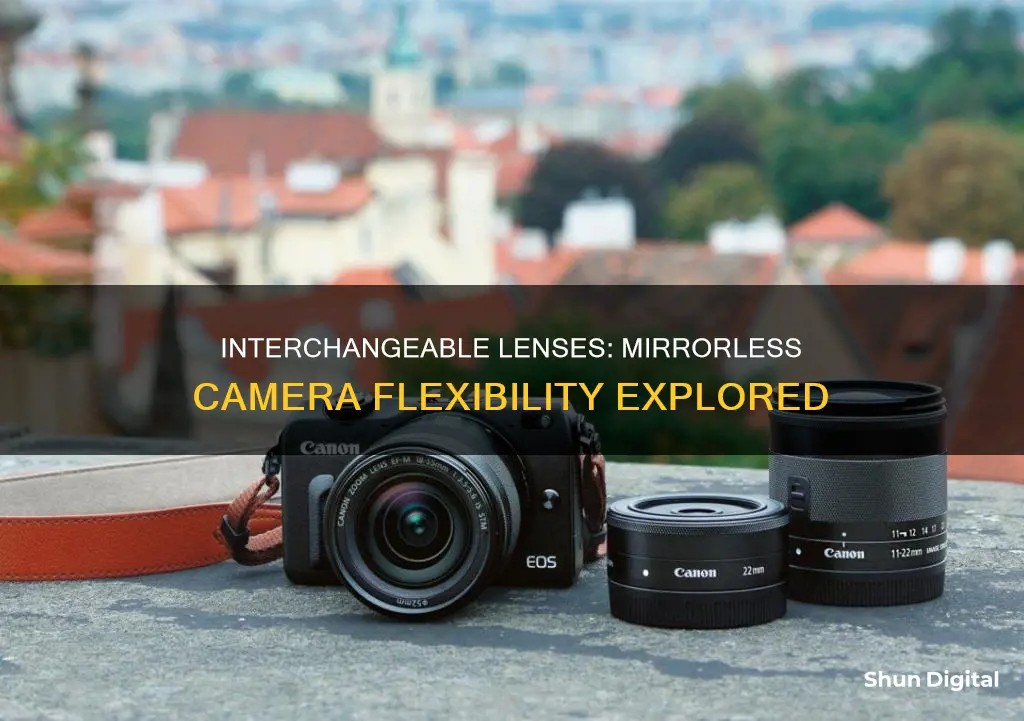
Mirrorless cameras are digital cameras that do not use a mirror to reflect the image into the viewfinder. They are also known as mirrorless interchangeable-lens cameras (MILC) and hybrid cameras. They are thinner and lighter than digital SLRs because they do not have a mirror mechanism. Mirrorless cameras have interchangeable lenses, and their selection has increased significantly over the years.
| Characteristics | Values |
|---|---|
| Definition | A digital camera that accepts different lenses but does not use a mirror to reflect the image into the viewfinder. |
| Other Names | Mirrorless interchangeable-lens camera (MILC), hybrid camera, compact system camera (CSC), mirrorless DSLR, mirrorless SLR |
| Body Thickness | Thinner than a DSLR due to the absence of a mechanical mirror |
| History | Introduced in 2008 and initially popular with amateur photographers migrating from point-and-shoot cameras |
| Viewfinder | Electronic viewfinder (EVF) |
| Image Preview | Preview of the image is available on the EVF, which is often an LCD screen on the back of the camera |
| Weight | Lighter than DSLRs |
| Size | Smaller than DSLRs |
| Battery Life | Shorter than DSLRs |
| Accessories | Fewer accessories available compared to DSLRs |
| Image Quality | Comparable to DSLRs |
| Autofocus | Slower than DSLRs |
| Video Quality | Comparable to DSLRs |
| Shutter Sound | Quieter than DSLRs |
What You'll Learn
- Mirrorless cameras are smaller and lighter than DSLRs
- Mirrorless cameras are what you see is what you get
- Mirrorless cameras don't suffer from light leakage during long exposures in daylight
- Mirrorless cameras have shorter battery life than DSLRs
- Mirrorless cameras have fewer accessories and third-party lenses than DSLRs

Mirrorless cameras are smaller and lighter than DSLRs
The smaller size of mirrorless cameras is advantageous for street, wedding, and theatre photographers who require a discreet camera that can shoot unnoticed. It also makes them ideal for travel and everyday use.
However, it's worth noting that the size of the camera body can be a drawback when using large lenses, as the setup becomes unbalanced, making it tiring and annoying to shoot handheld. Additionally, the use of adapters to attach DSLR lenses to mirrorless cameras can exacerbate this issue by pushing the lens further forward.
While mirrorless cameras are generally smaller and lighter, it's important to consider the size and weight of specific models and lenses when making a purchase decision.
The Myth of Camera Lenses: Curved Glasses Explained
You may want to see also

Mirrorless cameras are what you see is what you get
Mirrorless cameras are "what you see is what you get" cameras. This is because they are "what you see is what you get" cameras that always use the electronic viewfinder (or Live View) to show you what the mirrorless digital camera sees. You see the effects of changing camera settings (shutter speed, aperture, ISO) immediately. This will help you understand the exposure triangle and make it easier to work in manual mode, which is particularly useful for beginners.
The absence of a mirror mechanism in mirrorless cameras also makes them lighter and more compact. This is a significant selling point, especially for travel and everyday use.
However, the size of the camera body can be misleading. While the body may be small and light, the lenses required to illuminate the sensor can be large and heavy, making the camera system unbalanced. This can be annoying and tiring when shooting handheld with big lenses. Adapters can be used to pair DSLR lenses with mirrorless cameras, but this further unbalances the system.
Another drawback of mirrorless cameras is their shorter battery life compared to DSLRs. On average, the battery life for entry-level mirrorless cameras is about 300 shots, while high-end DSLRs can take up to 1000 shots with a single battery.
Despite these limitations, mirrorless cameras have become increasingly popular, with many professionals switching to this type of camera.
Lending Camera Lenses: A Unique Library Offering
You may want to see also

Mirrorless cameras don't suffer from light leakage during long exposures in daylight
Mirrorless cameras have several advantages over DSLRs, and one of them is that they don't suffer from light leakage during long exposures in daylight. This is because, unlike DSLRs, mirrorless cameras do not have an optical viewfinder, which can let light in and cause light leakage. Mirrorless cameras instead use an electronic viewfinder (EVF), which is a small, high-resolution LCD screen that is sealed off from the sensor and does not affect exposure. Therefore, there is no need to cover the viewfinder on mirrorless cameras during long exposures, as is necessary with DSLRs.
Mirrorless cameras are also smaller and lighter than DSLRs due to the absence of the mirror mechanism. However, the size advantage of mirrorless cameras is reduced when using larger lenses or adapters, as the weight distribution becomes unbalanced. Additionally, mirrorless cameras tend to have shorter battery lives than DSLRs due to the power consumption of the EVF/screen combo. Nevertheless, mirrorless cameras offer several benefits, such as improved video quality, faster shooting speeds, and more compact designs, making them a popular choice for photographers and videographers.
Camera Lenses: Is Price Tag Directly Linked to Quality?
You may want to see also

Mirrorless cameras have shorter battery life than DSLRs
The use of Live View on a DSLR can also impact its battery life, as it then functions similarly to a mirrorless camera with the sensor constantly powered. However, DSLRs typically have larger batteries and do not rely on Live View as much, giving them an advantage in terms of battery life.
While mirrorless cameras have shorter battery life, this doesn't mean they are less powerful or capable. They often have faster shooting speeds and are better for video due to their live view capabilities. Additionally, mirrorless cameras are usually lighter and more compact, making them a convenient choice for travel and everyday use.
To improve the battery life of a mirrorless camera, it is recommended to turn off the LCD display when not in use. Some mirrorless cameras also support USB charging, which can be convenient when travelling.
The Truth About Camera Lenses: Glass or Plastic?
You may want to see also

Mirrorless cameras have fewer accessories and third-party lenses than DSLRs
Mirrorless cameras are also compatible with a wide range of accessories, but DSLRs typically have more accessories and third-party lenses available. This is because DSLRs have been the standard choice for professional photographers for many years, while mirrorless cameras are a more recent development. As mirrorless cameras gain popularity, more accessories and lenses are becoming available.
Mirrorless cameras have a smaller sensor size than DSLRs, which affects the range of lenses that can be used. Mirrorless cameras typically use Micro Four Thirds sensors, which are smaller than the full-frame sensors found in DSLRs. This means that mirrorless cameras require smaller, more compact lenses. While this makes the camera system more portable, it can also be tiring and annoying when photographing handheld with big lenses.
Adapters can be used to attach larger lenses to mirrorless cameras, but this can make the camera system unbalanced and even more cumbersome. Removable battery grips can be added to improve the ergonomics when using heavy lenses, but this adds bulk to the camera system.
Overall, while mirrorless cameras have fewer accessories and third-party lenses than DSLRs, the gap is narrowing as mirrorless cameras gain popularity.
APS-C Lenses: Universal Fit for All Cameras?
You may want to see also
Frequently asked questions
A mirrorless camera is a digital camera that does not have a reflex mirror. Instead of an optical viewfinder, it gives you a preview of the image on an electronic viewfinder (EVF).
DSLRs have a mirror that reflects the light either upwards or downward into the camera's optical viewfinder. Mirrorless cameras, on the other hand, have no mirror and their imaging sensor is always exposed to light. DSLRs are also bulkier due to having more moving parts.
Yes, mirrorless cameras have interchangeable lenses. They are also known as "mirrorless interchangeable-lens cameras" (MILC).
Mirrorless cameras are smaller, lighter, and quieter than DSLRs. They also don't suffer from light leakage during long exposures in daylight and are what you see is what you get cameras, allowing you to see the effects of changing camera settings in real time.
Mirrorless cameras have shorter battery life and may have a more limited selection of lenses and accessories compared to DSLRs.


